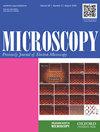用张量分解对串联电子全息图进行去噪
IF 1.8
4区 工程技术
引用次数: 4
摘要
在本研究中,通过模拟演示了一种使用张量分解的串联低剂量电子全息图降噪技术。我们将具有泊松噪声的系列全息图的整个数据集处理为三阶张量,这是一组2D全息图。将三阶张量分解为核心张量和三因子矩阵,仅使用无噪声主分量将其近似为低阶张量。通过假设半导体样品中的p-n结,将该技术应用于模拟全息图。使用张量分解,全息图和重建的相位图的峰值信噪比得到了显著改善。此外,考虑到条纹对比度和条纹相对于样品的漂移不均匀,该方法被应用于时间分辨原位电子全息术的更实际的情况。对重建的相位图的准确性和精度进行了定量评估,以证明其在束敏感材料的原位实验和低剂量实验中的有效性。本文章由计算机程序翻译,如有差异,请以英文原文为准。
Denoising of series electron holograms using tensor decomposition
In this study, a noise-reduction technique for series low-dose electron holograms using tensor decomposition is demonstrated through simulation. We treated an entire dataset of the series holograms with Poisson noise as a third-order tensor, which is a stack of 2D holograms. The third-order tensor, which is decomposed into a core tensor and three factor matrices, is approximated as a lower-rank tensor using only noise-free principal components. This technique is applied to simulated holograms by assuming a p-n junction in a semiconductor sample. The peak signal-to-noise ratios of the holograms and the reconstructed phase maps have been improved significantly using tensor decomposition. Moreover, the proposed method was applied to a more practical situation of time-resolved in situ electron holography by considering a nonuniform fringe contrast and fringe drift relative to the sample. The accuracy and precision of the reconstructed phase maps were quantitatively evaluated to demonstrate its effectiveness for in situ experiments and low-dose experiments on beam-sensitive materials.
求助全文
通过发布文献求助,成功后即可免费获取论文全文。
去求助
来源期刊

Microscopy
工程技术-显微镜技术
自引率
11.10%
发文量
0
审稿时长
>12 weeks
期刊介绍:
Microscopy, previously Journal of Electron Microscopy, promotes research combined with any type of microscopy techniques, applied in life and material sciences. Microscopy is the official journal of the Japanese Society of Microscopy.
 求助内容:
求助内容: 应助结果提醒方式:
应助结果提醒方式:


